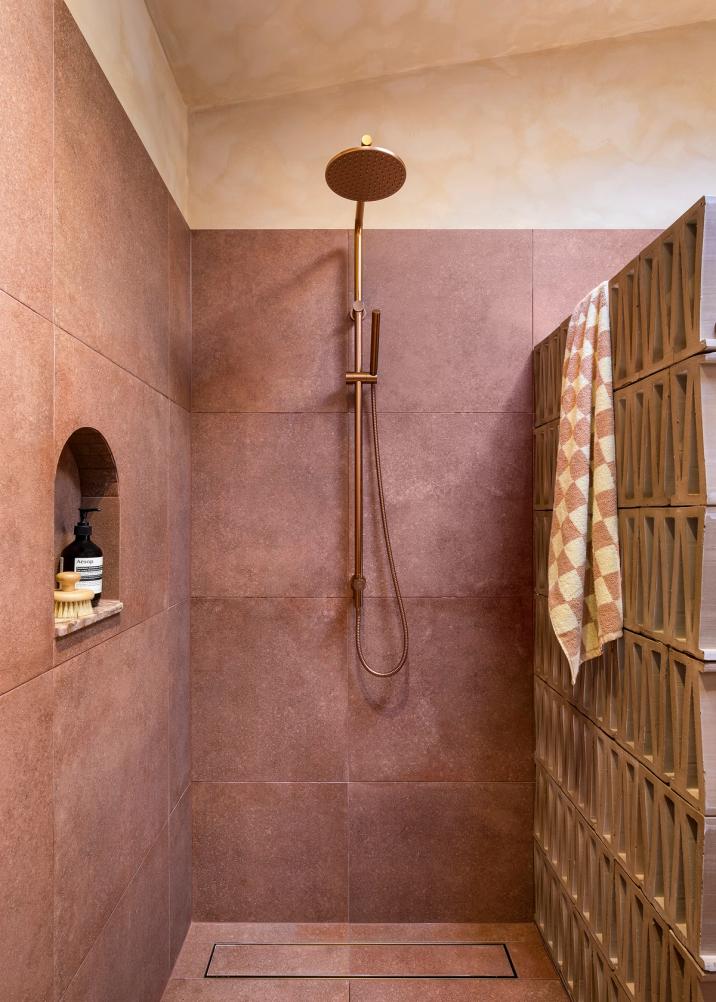
Tim Neve shares his tips for creating a functional yet spa-like retreat you'll enjoy using every day.
An Interior Designer’s Guide to Designing Your Dream Bathroom
Tim Neve shares his tips for creating a functional yet spa-like retreat you'll enjoy using every day.
Undergoing a bathroom renovation can be a daunting process. Where do you start with the design process? Which style do you go for?
There's a lot of consider, but if you get it right, you can not only increase the value of your home but create a sanctuary for relaxation and self-care.
We spoke to interior designer Tim Neve who has recently undergone his own bathroom renovation at home. Below, he shares what to consider when creating your dream bathroom, from finding a design that complements the style of your home, to adding design elements that can enhance the efficiency of daily routines.
Start with visual research
Designing a bathroom when you’re not an experienced designer can be an understandably overwhelming task. For Tim, starting at the tile store can make it even more overwhelming! “That will lead to indecision overload (even for a designer like me!) There are way too many hard surface options on the market these days.”
Instead, he suggests starting with some visual research to decipher what your favourite style is. “That could be as simple as scrolling through Instagram or Pinterest. I love to look overseas to see what American and European designers create in their interiors and see what elements translate to our Australian way of life.”
Find a design that complements the style of your home
Cohesive design creates a sense of visual harmony throughout the home. So when it comes to finding a style that would work for your bathroom, it’s worth looking at the existing style, materials palette, and/or colour palette of your home.
For example, Tim has used the same limewash paint from Bauwerk that features in the living areas of the home, and continued it into the bathrooms, wrapping the texture across the ceiling.
“In the past, the ‘all white’ bathroom trend meant we were creating sterile bathing boxes that didn’t hold any aesthetic resemblance to the rest of the home. I’m so glad that people are now seeing bathrooms as an extension of their home, breaking down the walls literally and flowing a cohesive style through open-plan ensuites for example.”
He stresses the importance of selecting colours that feature the same undertone as other rooms in your home. “If it’s a warm home and your bathroom colours have that same warm undertone they will always suit the style of the home, no matter what changes over time. Same with a cool palette, as long as there’s visual consistency it should feel ‘right’.
Opt for lighting that’s both functional and ambient
Lighting can make or break the ambience of any room. In your bathroom, it needs to set the mood while also being practical for getting ready.
“Lighting is all about placement! What are you trying to see? For example, at the vanity, you want both overhead and side lighting so that your face is well-lit from all angles – replicating the same view in the mirror you would get when you’re outside of the walls of the bathroom. I ensured the wall and ceiling lights are on different switches too, so I can create different moods at different times of day with the lighting choices.”
Opt for durable and stylish materials for surfaces
Choosing durable and stylish materials for surfaces in a bathroom is essential for creating a functional and aesthetically pleasing space.
Tiles are the backbone of a bathroom scheme, but trends and technologies are changing all the time.
"Most recently in our industry, natural stone is coming to the forefront and I’m so excited to see all of the individual options that nature has to offer – no two slabs of marble are ever the same! Bolder hues like onyx greens and rosa travertines are interesting choices to build a scheme around. And it’s no secret that Venetian Plaster and its more modern sister Microcement is having a moment. You can wrap a wet area in this material for a one-of-a-kind, seamless look that not only looks divine but is water-resistant and durable too."
Infuse your personality into the design
Bathrooms can be perceived as more challenging to personalise in design because functionality takes precedence. There are some style choices you can implement to make your bathroom reflective of your personality once you’ve worked out the functional layout.
Tim’s first suggestion is to steer away from ‘off the shelf’ bathroom mirrors and opt for a design with an interesting or sculptural shape – perhaps something vintage. “Make sure whatever you choose is made from a material that will withstand the humidity of a bathroom, as some metals for example will tarnish easily.”
The same goes for niches in your shower etc which don’t have to be in a simple square format. “I’ve recently created arches and other organic shapes instead to infuse a stronger look into the functional component. Just remember, the more complex the shape the harder it will be for your tiler to work around – so have an open discussion with your trades from the beginning about what you’re hoping to achieve, and if it’s possible.”
Just like how a cushion can transform a sofa, your towels can change up a bathroom look very easily. “I’m obsessed with check towels at the moment that easily inject some colour and pattern into a space.”
Add design elements that can enhance the efficiency of daily routines
Your bathroom is where you’ll get ready for the day, and unwind at the end of a day. Efficiency in a bathroom can be greatly enhanced by incorporating thoughtful design elements that streamline these daily routines.
“I’m a fan of dual vanities and double showers if the layout allows, as not only do they look doubly visually impressive, but it means the space becomes multi-functional, perfect for a busy family home.”
It’s also smart to consider design choices that can make a bathroom easier to clean and maintain. This includes frameless glass shower doors or open-concept showers to minimise the areas where soap scum and water spots can accumulate. Ensure there is proper ventilation to minimise mould growth.
Tim also says to be aware of non-slip tiles. “They sound sensible but actually have a surface treatment that feels almost like fine sandpaper. This makes them not the most comfortable underfoot, and near-impossible to clean as it will pull the fibres from the mop or sponge onto the surface.”
How to achieve luxurious bathroom feel on a modest budget
When trying to make your bathroom feel luxurious, even when working with a modest budget, Tim says it’s all about your choice of finishes.
“Large format tiles always feel more expensive. Marble-look tiles can trick the eye, and give the same effect as real stone. Most tile showrooms distribute samples, so play with different combinations of those before you land on a solution. Seek out tapware in rich tones like copper, brass or bronze that literally shine, but may be no more costly than plain chrome.”
Maximising space in a small bathroom
There's no denying small bathrooms present unique challenges. But there are some design choices you can take advantage of to maximise space.
“Vanities with curved corners take up less space and look attractive too. In a powder room, a wall-hung vanity with exposed plumbing is ideal for a small space as it doesn’t look visually heavy, literally floating so you can see all the floor space. You could also embrace a wet-area layout where a bath is placed behind the shower screen up one end of a room, creating clear zones and using your limited space more wisely.”
Elevate your new bathroom.
Enjoyed This?
Discover more bathroom content.







